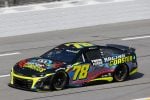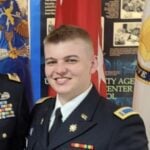In late 2004, a young Charles Denike was sitting patiently underwater adorned with his dive tanks and scuba mask. Suddenly, a force pushed him back and forth and knocked his mask loose.
He found his breathing tubes tangled and his mask unreachable. Unable to breathe, Denike had only moments to correct his apparatus and place his mask back on before he drowned. Calm and collected, he navigated his hands through the process. He found the knot and untied it. Finally, he placed his mask back on his face and was met with the relief of oxygen flow. He had averted disaster and potentially death.
Then he swam to the pool surface where he was met with his instructors. He had passed the test.
Today, you know him as 23XI Racing’s newest NASCAR Cup Series crew chief. In 2025, Denike was hired by the four-year-old race team to sit on Bubba Wallace‘s pit box after many successful years of NASCAR Craftsman Truck Series racing.
But 21 years ago, he was a young Army Engineer Lieutenant Denike, and he had only recently enrolled in the U.S. Army’s Combat Diver Qualification Course at the Naval Diving and Salvage Training Center in Panama City, Fla., where he was undergoing the scuba phase of the curriculum.
It is considered by many the most difficult course in the Army.
From when he was young, Denike always was a part of the racing community. Growing up next to a neighbor that owned a race team and cars, he found himself becoming increasingly involved in the sport. There is where he became fascinated by the mechanics of engineering.
“I grew up as a child next to a family that raced,” Denike told Frontstretch. “So from that moment, it was that just was like the cool thing to do, you know? I would come home from school, I’d do homework, I’d go next door and hang out in the garage. Go to the home track.
“I’d say it started more that side than like a NASCAR fan that then said, ‘Hey, I want to go through how to work in racing.’ I mean, we’re talking 10, 11 years old.”
However, upon enrolling into the University of Virginia, Denike’s racing career was put on hold when he joined the school’s Army ROTC program. For four years, Denike would learn the basics of military leadership en route to commissioning as a second lieutenant when he graduated in 2003.
When graduating, newly commissioned lieutenants are given the chance to select their branch of service. Denike, ever fascinated by things mechanical, got his first pick: the Army’s Corps of Engineers.
“I just kind of grew up in that in that kind of direction,” Denike recalled. “I felt like I grew up working with my hands. I don’t remember exactly when in my childhood I had an influence, but science, technology, you know, the STEM type of items were always the most interesting, so it just seemed like a natural [fit].”
While engineers typically are known for constructing, Denike also learned one of the core competencies of being an Army engineer: demolitions. In layman’s terms? They blow things up, too.
And yes, without skipping a beat when asked, he has a favorite memory of that.
“We imploded a barracks building,” Denike said immediately. “A controlled implosion using dynamite in all the columns to make the building just fall flat because we didn’t have enough radius of protective seclusion zone on that island. So we had to use some alternative methods.
“I would say that was the neatest explosive thing. I mean, we blew up a lot of stuff. But that one I remember pretty vividly.”
Shortly after attending his Engineer Basic Officer’s Leader Course in Fort Leonard Wood, Mo., Denike attended Army Sapper Leader Course. The Sapper school, a 28-day course comprised of a classroom, mountaineering, explosives and 10-day patrol phase, is considered as the engineer equivalent to the infantry’s ranger school. There, Sapper candidates learn the basics of combat engineering.
“You’re out in the field for 10 days and you’re applying everything that you’ve learned in real time through patrolling phases,” Denike explained. “You’re graded and evaluated on it. … The point of the Sapper Leader Course was to make better young leaders in the combat engineer field.”
Now a full-fledged Army engineer officer complete with a coveted Sapper tab, Denike had already completed the schools that was expected of him in only the span of a year. As many combat-role officers do, the young lieutenant was likely in line likewise take on the challenge of attending the ranger course.
Then he was offered something he thought was better: dive school. Unlike most other courses offered, the CDQC is only offered once every 18-24 months per Denike. It just happened that in the beginning of 2004, his graduation of his engineering courses lined up perfectly with the dive school’s selection process.
“It was purely a good timing for an officer to be able to go do [dive school],” Denike said. “Because … every 18 months or every two years, they need to select a few, and I just happened to be in the right class that was eligible to try out. So I did that.”
Denike was among 20 soldiers who signed up for the Army’s diving course. However, before he could even begin the first phase, he had to be selected by instructors, and for one of the prestigious and challenging courses in the Army, the sorting process is rigorous.
After taking a modified physical fitness test, exams and even an interviewing process, Denike was selected to attend the course.
Out of the original 20, he was among three that were picked.
“The selection criteria to get to go is very difficult because by that point, there’s so much invested in these candidates that it needs to succeed,” Denike said. “So then the graduation rate, hopefully, is good and not poor. We want us selected before we ever get there.”
From June to November 2004, Denike was put into some of the most rigorous training offered by the U.S. Army. For hours a day, he underwent diving techniques and procedures given by his instructors. All of it was meant to get candidates comfortable with being in perilous situations while underwater.
“What’s important to note is that you get taught and trained exactly how to do the task,” Denike explained. “Then you get graded on doing the test. So if you follow the training, all your tools were there that you needed to be successful. It’s just a matter of being able to control everything and manage to not panic. Stay calm.
“It’s challenging. … They try to rip your equipment off, and you have to put the stuff all back together. Yeah, it’s pretty neat.”
Yet Denike developed a sense of normality to the strenuous instruction. Upon experiencing the psychological and physical toll of nearly five months of constant training and education, Denike adapted to the course.
“I would just say the sustained level of strenuous activity in both physical and mental for five or six months is difficult,” Denike said. “It was challenging. But it also is very long. You can’t sustain yourself that at off-the-charts hard for six months straight, right? So, you get into a routine of it. It’s very technical. … You get kind of known to the level of difficulty of the strenuous activity. It becomes kind of normal.”
By the end of 2004, he was a newly certified Army combat diver and was assigned as the executive officer of the 7th Engineer Dive Attachment in Fort Shafter, Hawaii, where he remained for the next three years before moving on to being picked as the company commander for the Army Dive Company in Fort Eustice, Va., in 2007.
By 2009, Denike had undergone the most of a career dive officer in the Army. As a captain, there was little more path left for him to follow in the diving side of his career.
So in 2010 he returned to the engineer side of the military. While working with the 7th Sustainment Brigade, he traveled to Haiti to assist with the earthquake rebuilding in 2010 and to Afghanistan for a year in 2011.
Finally, in 2012, Denike had met the pathway all ROTC graduates meet in their career. He had to decide if he wished to stay in the military or to return to civilian life.
Even after nine years, the call of racing was still there.
“When I decided to get out of the Army is when I decided I wanted to pursue a professional career in racing as opposed to continuing my full career in the military to retirement,” Denike said. “So in 2012, I separated from the military and went to work for a NASCAR K&N Pro Series team at the time, which was my first venture into professional racing in the start of this part of my career.”
Almost right after leaving the armed forces, Denike picked up his first crew chief gig with Rick Gdovic in the Pro Series at Langley Speedway in 2012.
In 13 years since, he’s sat on the pit box for the likes of Greg Biffle, Tyler Ankrum and Justin Haley and won races with Chase Elliott and Christian Eckes.
While trading in his dive tanks and scuba masks for air guns and jack stands, Maj. Denike still applies his engineering knowledge into construction.
And even after all this time, he still retains a role of leadership while doing so.
Dalton Hopkins began writing for Frontstretch in April 2021. Currently, he is the lead writer for the weekly Thinkin' Out Loud column, co-host of the Frontstretch Happy Hour podcast, and one of our lead reporters. Beforehand, he wrote for IMSA shortly after graduating from Embry-Riddle Aeronautical University in 2019. Simultaneously, he also serves as a Captain in the US Army.
Follow Dalton on Twitter @PitLaneCPT





